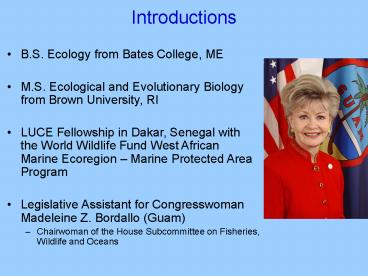Introductions - PowerPoint PPT Presentation
1 / 23
Title: Introductions
1
Introductions
- B.S. Ecology from Bates College, ME
- M.S. Ecological and Evolutionary Biology from
Brown University, RI - LUCE Fellowship in Dakar, Senegal with the World
Wildlife Fund West African Marine Ecoregion
Marine Protected Area Program - Legislative Assistant for Congresswoman Madeleine
Z. Bordallo (Guam) - Chairwoman of the House Subcommittee on
Fisheries, Wildlife and Oceans
2
Controls on carbon and nitrogen accumulation and
loss in arctic tundra ecosystems
Marselle Alexander-Ozinskas August 2008
3
Arctic Tundra
- Latitudes 55 to 70 North
- Accounts for 20 of earths land surface
- Low temperatures and short growing seasons
- ?Summer average temperature 12 C
- Winter average temperature -34 C
- Low biodiversity, low nutrients
- Presence of permafrost
- Low precipitation
4
Climate change and carbon storage
- Most of terrestrial C stocks are in soils.
- 1/3 of the global soil carbon pool is stored in
northern latitudes - These higher latitudes have warmed more than
equatorial regions in the past century - ? The dominant effects of warming on C stocks are
mediated by nitrogen, and corresponding changes
to the N cycle
The World's CarbonReservoirs Size (Gt C)
Atmosphere 750
Forests 610
Soils 2000
Surface ocean 1020
Deep ocean 38100
Fossil fuels
Coal 3000
Oil 500
Natural gas 500
Total fossil fuel 4000
Adapted from Kasting, 1998
5
Nitrogen
- Changes in ecosystem N are intrinsically linked
with changes in C due to stoichiometric
requirements for production of organic matter - Nitrogen is a limiting nutrient to growth in most
terrestrial ecosystems - Effects of warming alter the N cycle, changing
composition, productivity, and other properties
of many natural ecosystems
6
Simplified Soil N Cycle
Atmosphere N2
N2
N2O
NOx
Biological N fixation
Lightning
Small OM uptake
Soil Organic Matter
Mineralization
NH4
NO3-
NO2
Nitrification
N2O
NOx
Aerobic
Soil Organic Matter
NH4
Mineralization
Denitrification
Anaerobic
Leaching
(Adapted from Schlesinger 1995)
7
Effects of Warming
Atmosphere N2
N2
N2O
NOx
C
Biological N fixation
Lightning
Small OM uptake
Soil Organic Matter
Mineralization
NH4
NO3-
NO2
Nitrification
N2O
NOx
Aerobic
Soil Organic Matter
NH4
Mineralization
Denitrification
Anaerobic
Leaching
(Adapted from Schlesinger 1995)
8
(No Transcript)
9
What C and N cycling processes should be more
responsive to global warming? What are the short
and long-term controls over these processes?
What are the implications for overall arctic C
balance?
10
Fertilizer Addition
Atmosphere N2
N2
N2O
NOx
Biological N fixation
Lightning
Small OM uptake
Soil Organic Matter
Mineralization
NH4
NO3-
NO2
Nitrification
N2O
NOx
Aerobic
Soil Organic Matter
NH4
Mineralization
Denitrification
Anaerobic
Leaching
11
Long-term experimental plots
Fertilizer added as NH4NO3 at the beginning of
the growing season (early June) Added 10g N,
5g P m-2 y-1 for 20 years ? 200 g m-2 total N
added
12
Mack et al, 2004 Nature
13
Fertilized / non-fertilized (CT) tundra (heath)
plots
Fertilized greenhouse, moist acidic tundra
14
Mack et al, 2004 Nature
15
C and N linkages Effects of Climate Change
- After 20 years of fertilization, C losses are
larger than the increased C uptake, and must be
associated with corresponding accumulation and
loss of N - If N remains in system, fertilization, and thus
warming, will lead to greater C accumulation - If N is lost, it should lead to net C loss
16
Long-term fertilization of Alaskan tundra
? Where did all of the nitrogen go? ? What are
the long-term consequences for C storage?
17
Simplified Soil N Cycle
Atmosphere N2
N2
N2O
NOx
Biological N fixation
Lightning
Small OM uptake
Soil Organic Matter
Mineralization
NH4
NO3-
NO2
Nitrification
N2O
NOx
Aerobic
Soil Organic Matter
NH4
Mineralization
Denitrification
Anaerobic
Leaching
(Adapted from Schlesinger 1995)
18
Summary of Results
- Extrapolating the results of long-term
fertilization to the effects of climate warming,
denitrification could be an important N loss
pathway in the arctic following climate-driven
changes - Continuing efforts to distinguish what controls
this process and other nitrogen transformations
will help clarify constraints on arctic ecosystem
nutrient budgets and carbon storage abilities
19
Acknowledgements
Osvaldo Sala Skylar Bayer Ben Hudson Angela
Allen Pedro Flombaum Lara Reichmann Seeta
Sistla Lucía Vivanco Jon Witman Dave Murray
Gus Shaver Anne Giblin Jim Laundre Debbie
Scanlon Christina Maki Don Burnette
20
Fellowship Year - Guam
- Unincorporated Territory of the United States
- Land Area 212 square miles
- Population 154, 805 (2000 census)
- Language English and Chamorro
21
Legislation
- Coral Reef Resolution (H.Con.Res. 300)
- Coastal Zone Management Act Reauthorization (
H.R. 5451) - Shark Conservation Act of 2008 (H.R. 5741)
- National Sea Grant College Program Act
Reauthorization (H.R. 5618) - Sanctuary Enhancement Act (National Marine
Sanctuaries Act reauthorization, H.R. 6537) - Nonnative Wildlife Invasion Prevention Act (H.R.
6311)
22
Issues
- Multinational Species Funds
- Neotropical Migratory Birds
- Aquaculture
- Wildlife Without Borders
- Illegal Wildlife Trade
- Guam Military Buildup
- International Whaling Commission
- Illegal, Unregulated, Unreported Fishing
- Oceans 21 (H.R. 21)
- Captive Primates
- Menhaden
- Invasive Brown Tree Snake
23
(No Transcript)































